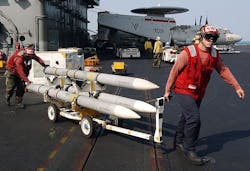Raytheon continues work to extend life of AMRAAM missile into 2020s with guidance system redesign
Officials of the U.S. Air Force Life Cycle Management Center at Eglin Air Force Base, Fla., announced $64.6 million contract option last week to the Raytheon Missile Systems segment in Tucson, Ariz., for phase 4b Form, Fit, Function Refresh (F3R) of the AMRAAM guidance section.
The Air Force and Navy AMRAAM is one of the nation's most sophisticated radar-guided air-to-air missiles, and one of the world's most advanced all-weather, all-environment, medium-range air-to-air missiles for engaging enemy aircraft and missiles from beyond visual ranges.
AMRAAM is an active radar-guided intercept missile with inherent electronic protection capabilities for air-to-air applications against massed penetration aircraft. AMRAAM has been in service since 1991, and was designed to replace the AIM-7 Sparrow air-to-air missile.
Related: Air Force orders hundreds of Raytheon AMRAAM air-to-air missiles in $573 million deal
The Air Force's AMRAAM F3R project is a comprehensive effort to mitigate the effects of parts obsolescence and diminishing manufacturing sources in the missile's guidance section to enable AMRAAM production beyond lot 31.
Raytheon won a $573 million order in March 2016 for AMRAAM lot 30 production. Each AMRAAM lot roughly consists of 400 to 500 missiles.
Mitigating the effects of obsolescence and diminishing manufacturing sources can involve the substantial redesign of subsystems by replacing electronic chips and other components that the original manufacturers no longer can produce.
In 2015 Raytheon experienced technical difficulties with the AMRAAM F3R application-specific integrated circuit (ASIC) design, hardware integration, and guidance section performance demonstration, which delayed the program's critical design review (CDR) for a year.
The Air Force awarded Raytheon an $8.6 million contract modification last December provide additional ASIC work as part of the AMRAAM F3R phase 4a project. That job is scheduled to wrap-up this June. Separately, Raytheon won a $104.6 million contract in May 2016 for AMRAAM F3R work on the missile's guidance section.
Last January Raytheon officials announced a project to develop a new signal processor for the AMRAAM under the F3R project to help ensure AMRAAM production well into the 2020s. Air Force officials say they plan to cut F3R technology into the latter part of AMRAAM lot 31 production in 2019 or 2020.
On last week's contract option, Raytheon will do the work in Tucson, Ariz., and should be finished by April 2018. For more information contact Raytheon Missile Systems online at www.raytheon.com, or the Air Force Life Cycle Management Center at www.wpafb.af.mil/aflcmc.
Learn more: search the Aerospace & Defense Buyer's Guide for companies, new products, press releases, and videos
